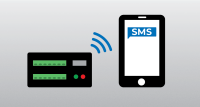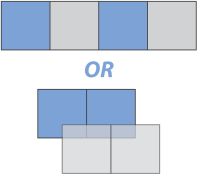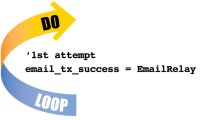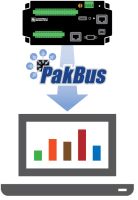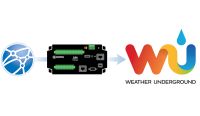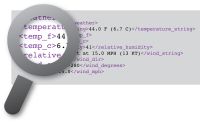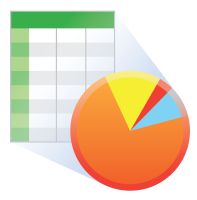El Blog de Campbell Scientific Sugerencias técnicas y recomendaciones de expertos
Displaying 1 - 20 of 28 articles tagged with: CRBasic
How to Keep Your Data Safe with PakBus® Encryption: Part 2
Autor: Shaurya Rastogi | Última actualización: 11/17/2025 | Comentarios: 0
In this second blog article in the series, I'll share with you additional practical steps that you can take to keep your automated monitoring platform secure. If you missed my first article about PakBus encryption or want to review it again, please read How to... leer másHow to Keep Your Data Safe with PakBus® Encryption: Part 1
Autor: Shaurya Rastogi | Última actualización: 11/03/2025 | Comentarios: 0
In today’s connected world, protecting your data is more important than ever, especially when it comes to environmental, industrial, or scientific monitoring. If you’re using an automated monitoring platform (also known as a data-acquisition system or data logger) from Campbell Scientific, strong security practices safeguard... leer másWhat You Should Know About Our New Training Option
Autor: Jacob Davis | Última actualización: 09/10/2024 | Comentarios: 2
The Campbell Scientific Learning Center is launching as a third training option, bringing self-paced learning to our customers. I am excited for this opportunity to expand our training availability beyond our current offerings: live, in-person training and live, online training. I hope you can take advantage... leer másDebería saber: Mejoras en envío de SMS con instrucción SMSSend()
Autor: Dana Worley | Última actualización: 04/09/2021 | Comentarios: 0
Do you currently use SMSSend() in a CRBasic data logger program to send SMS messages through a Campbell Scientific CELL2XX internal or external cellular module? There are some things you should know about the recent improvements we made that affect how SMSSend() works. With the release... leer más7 Things You Should Know about New Cellular Options for Data Loggers
Autor: Gary Roberts | Última actualización: 02/21/2018 | Comentarios: 3
You may have heard about the new integrated cellular modem gateways available as options on some of our data loggers. But, do you know what these options really offer, and how they can help your data communication needs now and for decades to come? In... leer másUnderstanding CRBasic Program Compile Modes: Sequential and Pipeline
Autor: Janet Albers | Última actualización: 10/25/2017 | Comentarios: 6
Have you ever noticed a message saying that your CRBasic program compiled in PipelineMode or SequentialMode? What does it mean? And, when does it matter? In this article, we’ll look at these two modes. Sequential Mode Let’s start with the more straightforward mode: SequentialMode. The CRBasic Editor... leer másUsing Loops in CRBasic to Prevent Unnecessary Skipped Scans
Autor: Gary Roberts | Última actualización: 05/31/2017 | Comentarios: 2
Maybe you’re like me when it comes to skipped scans. I have always disliked seeing skipped scans in my data loggers. I have been trained to watch out for them and do my best to write my CRBasic programs in a way that makes them... leer másUse Pointers to Make Your CRBasic Programs More Efficient
Autor: Gary Roberts | Última actualización: 03/23/2017 | Comentarios: 2
Pointers are a great tool for CRBasic programs. If you use them carefully, pointers can reduce the amount of program code you need to write, thereby increasing your program’s efficiency and enabling you to use less memory. (Your program can run faster because it does... leer másHow to Use Callback Capability So Your Data Logger Initiates Data Retrieval
Autor: Jacob Davis | Última actualización: 02/22/2017 | Comentarios: 8
Have you come across situations where you want your data logger to initiate data retrieval, rather than your PC? For example, do you have an environmental condition that you want to transmit alarm data for? Although IP-based communication is prevalent, sometimes you may need data-logger-initiated communication... leer másSending Email from Your Data Logger Just Got Easier!
Autor: Dana Worley | Última actualización: 01/25/2017 | Comentarios: 22
Have you had problems finding an SMTP server to use to send emails from your data logger? Are compatibility issues causing you to look for a work-around? Keep reading for a solution that may be just what you need. Some Background In 2006, we added the ability... leer másAvailable Security Measures for Internet-Connected Dataloggers
Autor: Dana Worley | Última actualización: 12/07/2016 | Comentarios: 2
The Internet of Things offers a lot of advantages in today’s culture. There are consumer devices that let you monitor and control mood lighting and music in your home, keep track of last week’s leftover dinner in your refrigerator, and help you brew a cup... leer másHow to Access Your Measurement Data Using DNP3
Autor: Paul Smart | Última actualización: 09/02/2016 | Comentarios: 1
Turning your Campbell Scientific data logger into a DNP3 outstation is a great way to allow systems that use the DNP3 protocol to have access to your live measurement data, as well as historical data. When you use your data logger as a DNP3 outstation, the... leer más¿Cómo almacenar datos del datalogger en una tarjeta de memoria?
Autor: Carolyn Ivans | Última actualización: 06/22/2016 | Comentarios: 7
You may have identified the need to add external data storage to your datalogger with flash-memory cards. But do you know which CRBasic instruction to use to do it? In this article, I’ll help you choose the most suitable instruction for your application. In a future... leer más¿Cómo acceder a medidas en tiempo real mediante Modbus?
Autor: Paul Smart | Última actualización: 04/07/2016 | Comentarios: 24
Did you know that you can turn your Campbell Scientific data logger into a Modbus TCP/IP server? Do you know why that’s a good idea? Campbell Scientific data loggers are commonly used as Modbus server devices. This means that the data logger is configured to... leer más5 Steps to Post Your CR6 Data to Weather Underground
Autor: Sam Utley | Última actualización: 03/23/2016 | Comentarios: 10
Note: It appears that after this blog article was written, Weather Underground has been phasing out the “PWS – Upload Protocol.” The following tutorial may or may not work currently or in the future. However, it continues to offer some insight into structuring a CRBasic... leer más6 pasos para importar datos al datalogger de un fichero XML externo en InterNet
Autor: Gary Roberts | Última actualización: 03/02/2016 | Comentarios: 1
Would it be helpful to include data from a reputable source with your own data? If you have permission to use another source’s data for free or by agreement, how can you easily extract the specific data you want to use without doing a lot... leer másVamos a conocer el protocolo DNP3
Autor: Paul Smart | Última actualización: 01/20/2016 | Comentarios: 0
Have you heard of DNP3 but been unsure of what it is or what it’s used for? In this brief article, I’ll introduce you to this communications protocol, its role in SCADA applications, and how you can use it with your Campbell Scientific equipment and... leer másHow to Convert Wind Directions in Degrees to Compass Directions
Autor: Jacob Davis | Última actualización: 01/06/2016 | Comentarios: 2
Do you feel lost when sifting through wind direction data that is listed in degrees? For example, can you picture in your mind what direction 195 degrees is? Would it be easier if your datalogger could put your data in compass directions instead? In this... leer másHow to Access and Control Your Raven Modem via TCP/IP
Autor: Gary Roberts | Última actualización: 12/09/2015 | Comentarios: 1
Have you ever wanted the ability to control your Raven cellular modem with your data logger? Would it be nice to be able to get data on the health of your cellular modem and its data network? Maybe you even want to reset your Raven... leer másCRBasic Tips to Simplify Data Post-Processing
Autor: Barbra Utley | Última actualización: 08/12/2015 | Comentarios: 3
You’ve collected your measurement data, but how do you easily make sense out of it? How can you simplify the post-processing of your data and start analyzing it sooner? In this article, I’ll explain how adding some code to your CRBasic program can save you... leer más

